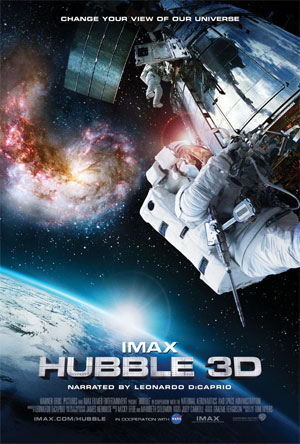Review: Hubble 3Dby Jeff Foust
|
| Hubble 3D follows a familiar formula: a celebrity narrator describes in understated tones the action on the screen and helps fit it into the big picture. |
For fans of the narrow genre of space-related IMAX films, though, 3-D is old hat. In 2002 IMAX released Space Station 3D, which took viewers inside the early construction of the International Space Station; in 2005 they revisited the Apollo landings in Magnificent Desolation: Walking on the Moon 3D (see “Review: Magnificent Desolation”, The Space Review, September 26, 2005). IMAX is back with its latest 3-D space spectacular, Hubble 3D, about everyone’s favorite space telescope and last year’s effort to repair it. However, the film also demonstrates that this genre is showing signs of age.
Hubble 3D follows a familiar formula: a celebrity narrator (in this case Leonardo DiCaprio) describes in understated tones the action on the screen and helps fit it into the big picture. Much of that action is associated with the STS-125 repair mission last year that revived the aging, ailing telescope, although there is background on the history of the Hubble and previous shuttle missions to launch and repair it (look for a brief shot of the STS-31 crew that launched Hubble 20 years ago that includes pilot Charles Bolden, now the NASA administrator.) The big picture is Hubble’s ability to peer into the cosmos, looking at the formation of other solar systems and the early history of the universe, rendered in the film in the form of 3-D computer-generated flythroughs of Hubble imagery.
| As beautiful as Hubble images are, it’s tough to compete with blue-skinned aliens flying extraterrestrial pterodactyls on a big screen in 3-D. |
One issue with the film is its identity: is it a movie about the space telescope itself, or about the mission to repair it? Most people might expect the latter, given the attention to the repair mission in the publicity leading up to the film’s release, but in reality it’s more the former, with the repair mission playing a prominent but not exclusive role. That’s a shame, since you could make a very good film about just the repair alone, which had drama uncommon to most contemporary shuttle missions. That drama, in the form of problems encountered during the repair spacewalks, is shown in the movie, but feels rushed: they have problems, but they’re quickly and successfully resolved. Likewise, one could do a very good IMAX film about Hubble’s discoveries alone, instead of just the couple of samples shown in Hubble 3D.
The bigger issue, though, has little to do with Hubble 3D itself but instead the evolution of movies in general. IMAX for years stood out as a premium movie experience, either in 2-D or, more recently, 3-D, but one limited primarily to documentaries. It was a rare case where reality was more dazzling than fantasy. That’s changing, though: not only are more movies embracing 3-D, more are also being shown on IMAX screens, both in 2-D and 3-D. That sets moviegoers’ expectations accordingly higher: as beautiful as Hubble images are, it’s tough to compete with blue-skinned aliens flying extraterrestrial pterodactyls on a big screen in 3-D. Fantasy retakes the lead over reality.
While other films have evolved, the IMAX space film has, beyond the addition of 3-D, changed little since The Dream Is Alive came out nearly a quarter-century ago. As good as Hubble 3D is—and it does have its visually stunning moments, even for those intimately familiar with the telescope and its repair—the encroachment of “regular” films into the once-elite world of IMAX signals it’s time to revisit how to best use these premium film technologies to communicate the wonders of space to audiences.
